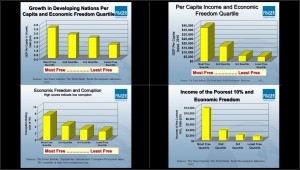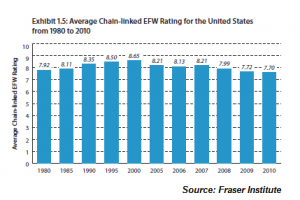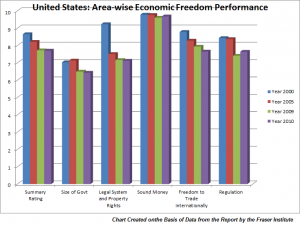The Canadian think tank Fraser Institute publishes an annual report assessing economic freedom throughout the world. The Institute released its latest 2012 report last week.
This annual survey is born out of a 25 year project that addresses the linkages between economic freedom and other variables, and was initiated by the renowned economist Milton Friedman. The result of the survey is the creation of an “Economic Freedom of the World Index” that relies on an overview of 42 government policies that impinge on economic freedom and encompasses 144 countries across the globe. These 42 policies broadly straddle the five main areas of the size of government, legal system and property rights, sound money, freedom to trade internationally, and regulation.
Economic Freedom
Economic freedom is defined as follows: “individuals have economic freedom when property they acquire without the use of force, fraud, or theft is protected from physical invasions by others and they are free to use, exchange, or give their property as long as their Actions to not violate the identical rights of others.”
According to the report, therefore, “the cornerstones of economic freedom are personal choice, voluntary exchange, freedom to compete, and security of privately owned property.”
Indeed, the Institute establishes that key economic metrics such as growth of GDP, income levels and corruption have a direct correlation with a degree of economic freedom enjoyed by a country, as shown by the info-graphic below:
The Economic Freedom Sweepstakes: How Countries Stack up
The 10 countries that are best performing on economic freedom, in descending order, are Hong Kong, Singapore, New Zealand, Switzerland, Australia, Canada, Bahrain, Mauritius, Finland and Chile. Note that the United States is not a part of this elite group.
Unfortunately the United States has been on a declining trajectory since the year 2000, when it ranked second, then eighth in 2005 and 19th in 2010. In 2012 the United States ranks 18th.
The reasons for the decline of the United States, according to the report are “massive growth in government financed by borrowing,” “the increased use of eminent domain to transfer property to powerful political interests, the ramifications of the wars on terrorism and drugs, and the violation of the property rights of bondholders in the bailout of automobile companies.” The report goes on to say that, “government consumption, transfers and subsidies, and government investment or rose during the decade,” and “the time cost of clearing customs increased and government borrowing consumed a substantially larger share of the credit market.” Area-wise the performance of the United States is shown below.
At the bottom of the heap, the 10 worst performing countries, in descending order, are Mozambique, Chad, Algeria, Guinea-Bissau, Congo (Dem), Angola, Congo (Rep), Zimbabwe, Myanmar and Venezuela.
The poster child for performance on improving economic freedom is probably Mauritius. It had a summary rating of 4.80 and a rank of 48 in 1975. Astonishingly, it improved to a rating of 7.90 and a rank of 9 by 2010.
Financial Crises
The report has an immensely useful section on the correlation of economic freedom with financial crises, a subject of burning topical relevance.
Based on analysis of financial data juxtaposed with economic freedom readings, the authors conclude that “our results from that crisis and prior ones indicate that higher economic freedom is associated with a lower probability of a banking crisis. And the effect is substantial. This is the opposite of what may well be conventional wisdom: “deregulation” or economic freedom more generally made the financial crisis more likely. Our results indicate this conventional wisdom is incorrect. More economic freedom makes banking crises such as the recent one less likely.” (emphasis added)
In fact the report goes on to say that a financial crisis accompanied with lowering economic freedom, which is the current trend in the United States, could result in another crisis: “If lower economic freedom makes a financial crisis more likely, responding to a crisis by lowering economic freedom makes a subsequent crisis more likely, not less.” (emphasis added)
That’s a sobering thought considering the series of monetary interventions (quantitative easing) witnessed in the recent weeks in the United States, Eurozone and Japan.
In conclusion, the report is a telling insight into how economic freedom around the world is trending, particularly in these troubled times of an uncertain economic outlook and massive monetary intervention.



Leave a Comment